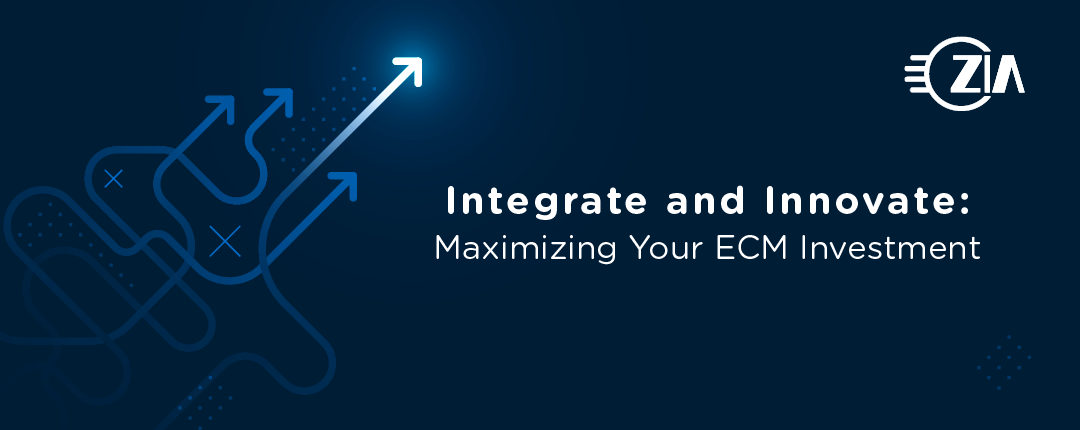Zia Consulting sent CEO Mike Mahon and Managing Partner Ryan McVeigh to ASG’s EVOLVE 2020 virtual conference. Their presentation—“See the Future, Work in the Now: Five Ways to Maximize Your Existing Investments”—addressed content services investments. At Zia, we offer a myriad of ways to maximize your ECM investment.
“Integrate and innovate,” they offered as one of the five ways to maximize your IT investments discussed at the event. In terms of integration to enterprise content repositories, the current state of the art as discussed was using technologies such as Simflofy and MuleSoft. I’ll expound a little on those two platforms here and discuss where you would use each respective platform.
Macro Projects
Simflofy
Simflofy is used to connect source content repositories to target content repositories as well as indexes such as Apache Solr. It’s based on the open source Apache ManifoldCF project. Typical use cases for Simflofy fall into two categories, content migration and content federation.
Zia Consulting has performed several successful migration and federation projects over the years for customers across multiple industries. Content migration is a process in which documents are migrated from a source repository to a target repository. This is typically done for one or more reasons. Technology refresh, consolidation of multiple repositories to a single repository, reconciliation of content as a result of mergers and acquisitions are but a few.
Content federation is a way to provide a “single pane of glass” across multiple repositories without the need to do a full migration. This is viewed as a lower cost approach as the often legacy content can be managed in place and allowed to age out.
MuleSoft
MuleSoft has arguably the world’s leading integration platform for tying together service oriented architecture, software as a service, and on-premise applications at the API (application programming interface) level. This includes but doesn’t necessarily orbit around content repositories. Where MuleSoft particularly shines is in cases where customers are trying to solve business critical challenges that require integrating various strategic business software platforms in a permanent or semi-permanent way. The types of projects include but aren’t limited to business automation, eCommerce, legacy systems modernization, mobile device enablement, and single view of a customer. As you might imagine, these are business critical use cases and as such involve extensive planning and resources for successful outcomes. The return on investment is typically quite high for these types of larger projects.
Although the Simflofy and MuleSoft integration spaces are of different natures, they share a commonality in terms of scope. Both of these technologies usually involve larger capital projects funded and managed at the corporate or division level of an organization. These are what I would refer to as macro projects.
Micro projects
On the other end of the spectrum are smaller departmental or even ad hoc integration projects. In other words, micro projects. These don’t always command the resources or time of the larger projects, but they require a more agile approach. Integration isn’t a one-size-fits-all proposition. Sometimes it requires a big hammer, and sometimes a lighter touch is called for.
This is an area where robotic process automation (RPA) comes into its own. RPA allows integration of applications without always depending on programming. In the most basic form, RPA mimics the actions of a human knowledge worker. It can go to websites, click on buttons, and do many other things that are frequently done by people. Knowledge workers do many complex tasks on a periodic basis involving many different systems. These various systems can be a mix of modern as well as legacy including mainframe. Among these systems are ECM repositories. Unstructured data is a key piece of the puzzle as both a source and a target. Integrating this eclectic mix of environments at an API level to automate the performance of routine tasks such as monthly closing isn’t viewed as a worthy return on investment.
In many cases, it’s simply not feasible to integrate such dissimilar platforms. This is precisely where RPA, acting as a person, would work. Once an RPA platform is in place, it provides a foundation for many of these smaller micro projects. RPA-based integration doesn’t need to involve programmers. Sometimes they don’t even need IT staff, but instead can be taken on by trained knowledge workers. This allows for a true democratization of process integration. Many important but smaller micro integration projects don’t get the attention or funding as their larger macro counterparts.
UiPath
UiPath—one of Zia’s technology partners—is the leader in the RPA space. It is a great platform for knowledge workers and other non-programmers to integrate applications by dragging and dropping activities into sequences, workflows, and even state machines. UiPath can work with human-level artifacts, such as spreadsheets. Just as easily, it can work with larger applications and user interfaces of all types.
One of UiPath’s key differentiators is the ability to introduce custom activities. These custom activities enable UiPath to do things that aren’t available out of the box. As a content management focused company, when we started working with UiPath, we noticed that of the many different integrations available in the platform, none were with traditional content or ECM platforms.
Recently, Box released some custom UiPath activities, but not any that can be used to work with ECM as a whole. This is why we’re happy to report that Zia has created a set of custom UiPath activities to address this space. This means that even at the micro project level integration with content management and unstructured data is now possible. These activities provide access to not only the managed content files, but critically they also can work with the associated metadata to get or create a holistic view of the content in context.
Taken together, many micro projects can have an aggregate impact equal to or greater than one or more macro projects. We’re excited about the potential and promise that this holds for our customers and partners.

